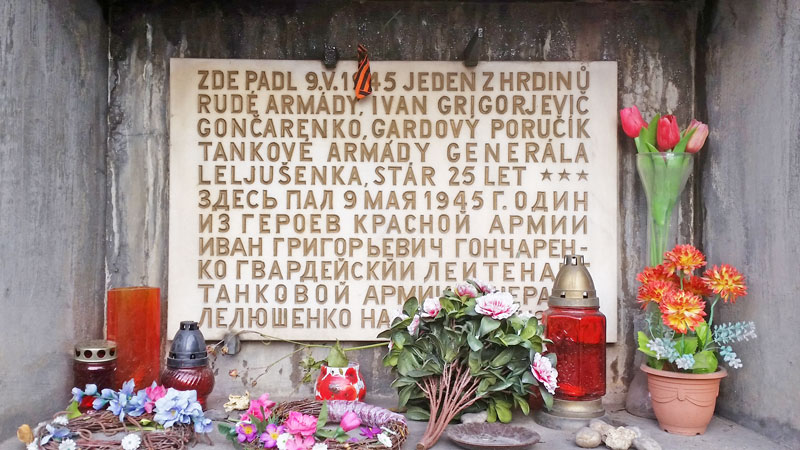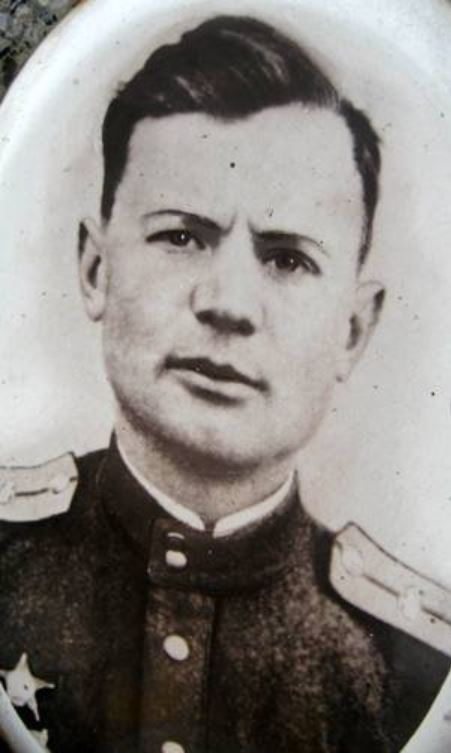Ivan Gončarenko
Every now and again I start researching an apparently simple story which takes you in different unexpected directions. The story of a death of a soldier is not uncommon in Prague. It’s how he died, when and where, where he was buried then, where he’s buried now and how he came to be used by the Communist regime.

The story starts with a memorial plaque for a man called Ivan Gončarenko (phonetically you would read it like Goncharenko). It translates as “Here fell on May 9th 1945 hero of the Red Army Ivan Grigorijevic Gončarenko, Guards Lieutenant of the Tank Army of General Leljusenka, aged 25”.
Ivan Gončarenko was a “tanker”, a lieutenant officer in charge of a T-34/85 tank who was killed in the Klarov area of Prague. Today if you went to the Malostranska metro station and walked up the hill past a small park until you reach the first building, it’s here that he died.
When Did He Die?
In “western European” countries when you learn about World War Two in Europe you are taught that it ended with German surrender on May 8th. Even today in the Czech Republic May 8th is commemorated but in the Communist regime 1948-89 they commemorated May 9th. This was because it was the day that Soviet Red Army forces entered Prague. So Ivan Gončarenko died on the morning of May 9th.
How Did He Die?

Even though the war had officially ended, the Germans had no faith that the Red Army would simply let them surrender and be returned to Germany. In particular the SS units knew their fate and they fully expected to be executed if captured. The remnants of the German Prague garrison was retreating west and they left a rear guard which contained “Hetzers” (the self-propelled 75mm guns were a match for the Soviet light tanks), to slow down the advance of the Soviet armour.
As Ivan Gončarenko led a group of three T-34/85 tanks marked I-23, I-24 and I-25 down the hill they were engaged by the German guns. Details are sketchy but although the Ivan Gončarenko’s tank did not receive a direct hit as displayed by the picture above, the occupants of the tank, Gončarenko, driver, loader and a Czech civilian were all injured by a shrapnel blast. Only Gončarenko died. If you are using the old castle steps at the rear of the castle then at the bottom of those steps is the building on the left in the photo.
Where Was He Buried?
It’s May 9th 1945, a warm day. If soldiers were killed then they had to be buried quickly and late in the afternoon of May 9th the body of Ivan Gončarenko was taken 400 metres over the Manes Bridge for burial in the square in front of the Rudolfinum with at least 3 others. Over the next few days some 10 other soldiers were buried here. Later the bodies were exhumed and transferred to a special Red Army military section of the Olšany Cemetery but for 40 years that square was officially called the “Square of Red Army Soldiers”. Today it’s Jan Palach Square. On a side note, the Soviets frequently told of “hundreds” of soldiers being killed by the German army during the liberation of Prague. Historians dispute both the number and how soldiers died. But that’s for another day.
What Happened Next?

So far it’s been a straightforward story, soldier dies, soldier gets buried. Then the propaganda begins. On July 29th 1945 a “Memorial to Soviet Tank Crews” was created and the associated square renamed in 1951 to “Tanker’s Square”. The story was spun that this was Tank I-23 the first tank to enter Prague and it’s officer, Lieutenant Ivan Gončarenko was killed during the fighting. But now we know that 1) Ivan Gončarenko commanded T-34 tank I-24 in the battle, 2) tank I-23 was the first tank to be seen on the Old Town Square on the morning of May 9th literally minutes after Gončarenko had been killed and 3) the tank installed as the memorial was a heavier tank called an IS-2. For those of you not familiar with the Russian alphabet, where the letter “I” used above refers to “Iosef” or in English “Joseph”. In this case the IS-2 was “Joseph Stalin mark 2”.
So in the end it’s the story of a brave young man killed in action, the circumstances of his death twisted and ultimately used for political propaganda.
Something Related or a Few Minutes Away
History/WW2 – Thomas Vokes and William Greig
History/WW2 – The WW2 Accidental Bombing of Prague
History/WW2 – The Prague Uprising
Parks and Gardens – Prague Castle Imperial Gardens
